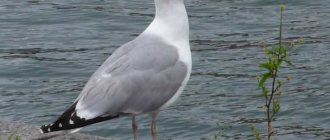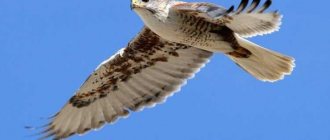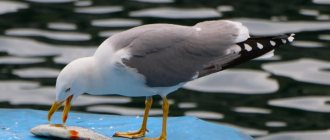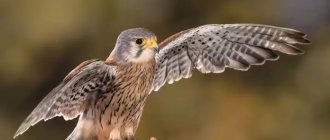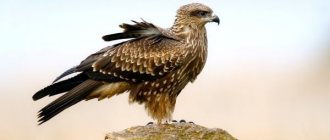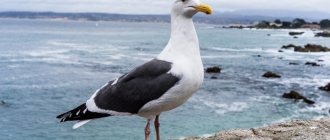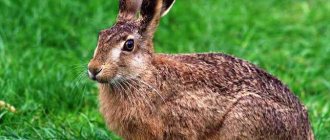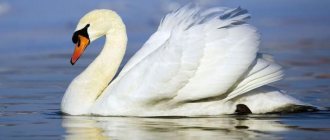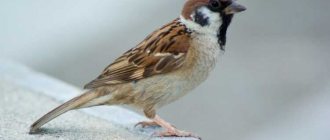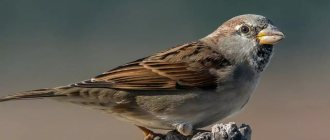| Latin name: | Larus |
| English name: | Gull |
| Kingdom: | Animals |
| Type: | Chordata |
| Class: | Birds |
| Squad: | Charadriiformes |
| Family: | Gulls |
| Genus in subfamily: | Seagulls |
| Body length: | 40-79 cm |
| Wing length: | 28-86 cm |
| Wingspan: | 80-170 cm |
| Weight: | 100-2000 g |
- 6.1 Jacks
Description of the bird
The gull genus includes many species, for which some common characteristic external features can be identified. As a rule, these are large or medium-sized birds, their plumage is usually white or gray, often decorated with black markings on the head or on the wings. One of the distinctive features is the strong beak of gulls, slightly curved at the tip, as well as developed swimming membranes on the paws.
What does it eat?
Seagulls eat a wide variety of foods; if necessary, they can easily switch from one type of diet to another. In coastal regions, gulls hunt and catch fish, crustaceans, mollusks, echinoderms, and aquatic worms in the sea. In search of prey, they first look for it near the surface of the water, without diving completely, but only lowering their head or part of their body into the water. Occasionally, birds may circle above the water in search of food. If the prey of a seagull is an animal covered with a shell or shell (a mollusk or crustacean), then the bird lifts it into the air and throws it onto the stones from a great height to break the hard shell. Seagulls also readily feed on waste near fishing vessels and enterprises that process seafood products. On land, gulls consume both plant and animal food (rodents, lizards, chicks and eggs of other bird species, insects and their larvae, berries, grain). They can eat carrion and food waste. In addition, gulls can destroy other people's nests and take prey from other bird species, for example, terns, cormorants, skuas, puffins, and ducks.
Features of character and lifestyle
Recommended by topic
Hippopotamus (hippopotamus) Hyenas Hamster
Seagulls are most active during the daytime. For the most part, they are engaged in trying to find food for themselves. Since seagulls are quite voracious birds, this task becomes of paramount importance for them. In an attempt to find food, they can fly a considerable distance from their habitat, but in the evening they return to the nest to spend the night. In this way, seagulls take shelter from the wind and escape from adverse weather conditions. In addition, a large flock can scare away natural enemies that the birds could not cope with alone.
Seagulls are distinguished by their originality and great ingenuity, which manifests itself in different circumstances. So, for example, if a bird is not able to open a found shell with its beak, it can throw it from a height onto the stones so that the shell cracks from the fall.
Sometimes birds are found in cities, where they settle near artificial reservoirs. There, seagulls can obtain a significant amount of food by begging for it from people. Birds can organize such feeding either independently or through a flock. If a bird decides to eat alone, this can lead to conflict between relatives.
Gulls live in one territory in colonies, the number of which varies from 500 to 5000.
The nests of all neighbors are nearby - at a distance of no more than ten meters. Although living in this format allows the flock to protect itself from predators and has various advantages, it also has some disadvantages. For example, seagulls do not get along well with each other and often provoke conflicts among themselves, which arise due to food or due to intrusion into someone else's territory.
Seagulls are capable of stealing food from their neighbors if they are not watching. When this fact is discovered, a collision occurs between the birds through a fight using a beak and sharp claws.
The lifestyle of seagulls largely depends on the current weather conditions. This is due to the fact that climatic conditions determine how much food the seagulls can get. If conditions are poor, seagulls may not lay eggs at all. At the same time, they will sit in the nests as if they were actually incubating them. If climatic conditions do not provide for stable nutrition, seagulls are capable of completely changing their place of residence, moving the entire flock to another territory.
Some species of gulls, such as black-headed gulls, can take prey from birds that are smaller than them. Seagulls swoop down on other birds and attack them with their beaks, forcing them to let go of their prey in order to defend themselves. After the food has fallen, black-headed gulls drive away the small bird and appropriate the results of its labors for themselves.
Each gull has its own small area within the vast territory occupied by the bird colony.
The bird protects this piece of land from relatives and other competitors. If a stranger enters this territory, a fight will immediately begin. In the event of an invasion by other predators or people, the colony comes to the rescue, raises a cry, flies into the sky and tries to drive out the uninvited guest by firing droppings.
Types of seagulls
Herring gull (Larus argentatus)
A large bird with a body length from 54 to 60 cm, a wingspan of 123-148 cm, weighing from 720 to 1500 g. In breeding plumage, the head and neck are pure white; in winter, dark streaks appear on them. The belly and tail are white. The body and wings above are bluish-gray. The beak is straight, flattened on the sides, with a tip curved downwards, greenish or yellow in color, with a red spot on the mandible. The iris is light yellow or silver-gray. The paws are reddish-pink. Young birds have noticeably variegated plumage: the feathers on the forehead, chin and sides of their heads are dirty white with longitudinal brown stripes and spots. The body is brown on top, with whitish or ocher edges. The herring gull lives in the northern hemisphere, both in the north and in the tropics. In Europe, the northern borders reach the Scandinavian Peninsula, in Asia - the coast of the Arctic Ocean east of Taimyr, in America - to Baffin Island and the polar regions of Canada and Alaska. In the south, birds nest all the way to the Atlantic coast of France, in America - south of the Great Lakes. Northern populations are migratory and migrate to the southern regions in winter. The habitats of the herring gull are various bodies of water. Birds inhabit the shores of seas, lakes, rivers, reservoirs, and swamps. They often nest on islands where there are no predators. Since the end of the 20th century, the herring gull began to appear in large cities, where it makes nests on the roofs of buildings.
Black-tailed gull (Larus crassirostris)
Medium sized bird. The plumage on the head, belly and sides is white, the back and wings are gray. There is a black stripe on the tail, the beak is black with a yellow stripe and a red spot at the tip. Paws are yellow. The young are dark brown. The species is distributed in eastern Asia, China, Taiwan, Japan and Korea. Also found in Alaska and North America.
Gray gull (Leucophaeus modestus)
Body length up to 45 cm. Weight from 360 to 400 g. Adult birds are feathered in lead-gray color, the back is always darker than the belly. In breeding plumage the head is light gray, in winter it is dark gray. The beak and legs are black, the iris is brown. The wings are dark gray. There is a black stripe with a white border on the tail. The species nests in South America, Chile, Peru. Also found on the Pacific coast.
White-eyed or Red Sea gull (Larus leucophthalmus, Ichthyaetus leucophthalmus)
— Advertising —
A slender, medium-sized bird. Its body length is up to 43 cm, its wingspan is from 100 to 110 cm. In breeding plumage, the head and neck are painted black, with a wide white stripe above and below the eyes. The chest and shoulders are light gray, the back is slightly darker, the rest of the body and tail are white. The wings are grayish at the base, then black. The beak is thin, long, with a red base and a black tip. The iris is dark, the legs are greenish-yellow. The bird lives on the coast of the Red Sea and the Gulf of Aden. Occasionally found in Turkey, Israel, the United Arab Emirates, Oman, Iran.
Common gull (Larus canus)
Outwardly it resembles a kittiwake, its body length is up to 43 cm, its wingspan is about 120 cm. Weight is from 300 to 550 g. The plumage is white, the wings are gray on top. The tips of the wings are black and white, the legs and beak are yellow-green. The lifespan of the common gull reaches 25 years. The species is distributed in Eurasia and North America. Some populations migrate to the Mediterranean Sea or northern Africa in winter.
Audoin's gull (Larus audoinii)
Body length is up to 51 cm. The wingspan is 115-140 cm. Weight is from 500 to 600 g. The species is rare, found in Greece, Cyprus, Spain, Algeria, Italy and Corsica. The largest colony is located in northeastern Morocco, containing two-thirds of the entire population.
Delaware gull (Larus delawarensis)
The bird's body length is from 41 to 49 cm, its wingspan is from 112 to 124 cm. The gull is slender, with a large head. The wings are long and thin, sharp at the ends. The tail is straight and short. The beak is short, thin, the tip is curved like a hook. The plumage on the back and wings is light gray. The tops of the flight feathers are black. All other plumage is white. The paws and iris are yellow. There is a patch of bare red skin around the eyes. In breeding plumage, the head becomes white, and a black transverse stripe appears in front of the top of the beak. The Delaware gull is a resident of North America, where it nests from southern Canada to the middle of the USA. In winter it flies south.
California gull (Larus californicus)
Externally, the bird is very similar to the herring gull, from which it differs in a small yellow beak with a black ring, yellow legs and a rounder head. The body plumage is white, except for the gray back and upper part of the wings. Juveniles are brown feathered. The species is distributed in North America, from Canada to eastern California and Colorado. For the winter it migrates to the Pacific coast.
Sea gull (Larus marinus)
The largest species of gulls with a body length of up to 75 cm and a weight of up to 2 kg, its wingspan is about 170 cm. The upper side of the wings is painted black, the rest of the plumage is white. The beak is large, yellow with a red tip. Legs pale pink. Young birds are brown feathered until the age of 4 years. Habitat: the coasts of the North Atlantic Ocean and Central Europe. In winter, individual populations migrate to the southern regions.
Dominican Gull (Larus dominicanus)
Body length is up to 58 cm, wingspan is 125 cm. The plumage on the head, neck, belly and tail is white, the back is black. The beak is yellow with a red spot. The legs are yellow or greenish. The species lives on the coast of South America and South Africa, as well as in New Zealand and the subantarctic islands in the southern oceanic belt.
Grey-winged gull (Larus glaucescens)
A large bird with a body length of 50 to 68 cm, a wingspan of 120-150 cm, and a weight of 850 to 1700 g. The head, neck, chest and belly and tail of the bird are white, the wings and back of the body are pearl-gray. The young are brown or gray with a black beak. The grey-winged gull is distributed in western Alaska up to the coast of Washington state.
Western gull (Larus occidentalis)
Body length is from 53 to 56 cm, wingspan up to 137 cm. The head, neck, tummy and tail are white; in winter, gray stripes appear in the head and neck area. The back is gray, the wings are decorated with black feathers. The beak is yellow with a red spot. Paws are pink. The young are brownish-gray in color with white streaks on the back. The wings and tail are black, the legs are brown. The species lives along the west coast of North America.
Cortez's gull (Larus livesns)
Body length is from 53 to 58 cm. The plumage on the back and wings is gray to black. The head is white. Paws are yellow. The beak is large and yellow. The species is distributed in northwestern Mexico and California.
Arctic or Iceland gull (Larus glaucoides)
Body length is from 50 to 66 cm, wingspan is 115-140 cm. Weight is from 820 to 1100 g. The plumage of the bird is light gray, the beak is yellowish-green. Young birds are lighter than adults. The tail is slightly darker than the entire plumage. The beak is thin. Lives in the Arctic regions of Canada and Greenland. Winters in the north Atlantic Ocean to the British Isles, as well as off the northeastern coast of the United States.
Thayer's gull (Larus thayeri)
Body length from 55 to 65 cm. Wingspan from 142 to 152 cm. Weight 700-1100 g. In breeding plumage it looks like a herring gull. The beak is yellow with a red spot on top. The rainbow is dark. Paws are reddish. There is a red ring around the eyes. The wings are gray with black and white feathers. In winter plumage, the head is mottled with dark brown. The species lives on the western coast of Hudson Bay and on the Arctic islands of Canada. In winter it migrates to the west coast of North America.
Mediterranean gull (Larus michahellis)
The bird's body length is from 52 to 58 cm, its wingspan is from 120 to 140 cm. Adult birds have a white head, neck, back of the head, tummy and tail. The back is light gray. The beak and irises are yellow, there is a red ring around the eyes. Paws are yellow. Young birds have gray-brown plumage. The Mediterranean gull lives along the coast of the Iberian Peninsula and the Bay of Biscay. It is also found in the Mediterranean basin up to the Black Sea.
Laughing Gull or Steppe Gull (Larus cachinnans)
A large slender bird with a small head, sloping forehead, long and thin beak, and long legs. Body length is from 54 to 66 cm, wingspan is 130-158 cm, weight is from 700 to 1200 g. The species is distributed in Russia and Ukraine near the Black and Caspian Seas, as well as in Kazakhstan, Hungary, Belarus and Poland.
Armenian or Sevan herring gull (Larus armenicus)
In appearance, it resembles a yellow-legged gull, but it is smaller in size, with a dark gray back and a dark iris. The wings have wide black stripes with white spots. The beak is short, with black stripes at the end. The young are brown in color. Habitat: Armenia, Georgia, Turkey and western Iran. The bird winters on the coasts of Turkey, Lebanon and Israel.
Black-headed gull (Larus ichthyaetus)
Large bird. The plumage on the body is white, the head is black, the back and wings are ashen. The beak is orange with a black stripe at the end. Distributed in the Crimea, on the Sea of Azov, off the coast of the Caspian Sea and in the eastern Mediterranean Sea.
Brown-headed gull (Chroicocephalus brunnicephalus)
A small seagull. The head of adults is pale brown, the back is pale gray, and the beak and paws are red. The brown "hood" disappears in winter. The species nests in lakes of Central Asia from Tajikistan to Mongolia and China. The bird is migratory and winters in South Asia.
Grey-headed gull (Larus cirrocephalus)
The bird's body length is up to 42 cm. In summer, adults have a light gray head and gray body. The belly is dark gray to black. Habitat: South America and Africa to the south of the Sahara. In winter, the bird flies to Spain and North America.
Hartlaub's gull (Larus hartlaubii)
Outwardly, it is very similar to the grey-headed gull, but is slightly smaller in size. Body length is from 36 to 38 cm. The beak is thin and dark, the eyes are dark. The legs are colored dark red. The head is light gray, and during the nesting period it is white. Hartlaub's gull lives on the Atlantic coast of South Africa and Namibia.
Australian gull (Chroicocephalus novaehollandiae)
The bird's body length is from 36 to 44 cm. Wingspan is 91-96 cm. Weight is 265-315 g. The head, tail and abdomen are white. The back and wing coverts are pale gray. The wings are black with large white spots. The beak and legs are bright red. The species breeds in Australia, Tasmania and New Caledonia, along the coast, on islands and large lakes.
Red-legged Gull (Chroicocephalus scopulinus)
A medium-sized bird with a white head, body and tail, its wings are light gray. Legs and beak are red. Distributed in New Zealand. Rarely found in Australia.
Black-headed or common (river) gull (Larus ridibundus)
A small bird with a round head and a thin beak. Its body length is from 35 to 39 cm, its wingspan is 86-99 cm, its body weight is from 200 to 350 g. During the mating season, the head is dark brown to the back of the head, where the light plumage begins. There is a white rim around the eyes. The back of the head, neck, chest, tummy, tail and rump are white. The wings are gray on top. There is a wide white stripe on the upper front part of the wing, and the rear part is bordered with black - this is a characteristic feature of the plumage. The beak is burgundy, curved down. Brown rainbow. In winter plumage, adult birds have a white head with black-gray spots, a light red beak with a dark tip, and light red legs. Young birds are reddish or gray-brown in the area of the head and upper body. The bird lives in the Black and Mediterranean Seas.
Sea pigeon (Larus genei, Chroicocephalus genei)
Body length is from 39 to 47 cm, wingspan is about 97 cm. It looks like a black-headed gull, but its head is dark. The neck, belly and tail are pink, the wings and back are grey. The beak is thin. Legs are red. Young birds have a gray back, white belly, and gray spots on the head and back of the head. The beak is yellow-orange, the paws are yellow. The species is distributed in the south of the Mediterranean Sea, in the Red Sea, in the Persian Gulf, on the coasts of the Black, Caspian, Aral Seas, in Turkey, Iran. oicocephalus philadelphia) Body length from 28 to 30 cm. Wingspan up to 100 cm. Weight 180-230 d. In breeding plumage the head is dark gray or black. The beak is black. There is a noticeable red ring around the eyes, the iris is dark brown. There are white spots above and below the eyes. The back and tail are white, the chest and belly have a pink tint. Paws are red. In winter, there is no cap on the head. Bonaparte's gull nests in southern Alaska. In winter, the bird migrates to the coast of the United States of America.
Black-headed gull (Ichthyaetus melanocephalus)
A small bird with a strong build and a large, round head. Body length is up to 39 cm, wingspan is about 98 cm. The wings are long and pointed. The beak is short. In breeding plumage the head is black. The wings are light gray. The rest of the plumage is white. The legs and beak are dark red. The winter outfit does not have a black hood; gray stripes appear on the back of the head. Inhabitant of Europe and the Mediterranean. Occasionally found in North Africa.
Relict gull (Ichthyaetus relictus)
Body length is from 44 to 45 cm. The head and neck are black. There are white spots above and below the eyes. The back is light gray. The belly and tail are white. The wings are light gray with black edges. In winter plumage the head is white. The beak and paws are dark red. Young birds have white head plumage with brown spots. Colonies of the relict gull live in Kazakhstan, Russia and China.
Little gull (Larus minutus)
The smallest species with a body length of 24 to 28 cm, a wingspan of 62-69 cm, and a weight of about 100 g. Outwardly similar to the black-headed gull, but differs from it in its completely black head. During the mating season, the belly, sides, chest, lower part of the neck, undertail and rump are white, sometimes with a pink tint. The head and upper neck are black. The back and wings are light gray. The dark red beak is short and thin. The iris is dark brown. There is a white border around the eyes. Legs pink, short. In winter plumage, the head is white, with dark gray spots in the crown, on the back of the head and behind the eyes. Distributed in Eurasia.
Reproduction
Most seagulls are monogamous birds. Birds arrive at their nesting sites in the spring. And they begin to conduct their mating games, during which they scream loudly, throw back or tilt their heads, bend, feed each other. Seagulls nest in colonies, which consist of several tens or thousands of pairs, sometimes they can nest one pair at a time. Birds often occupy their old nests or build new ones.
Nests
The gull's nest is located in open places, right on the ground (on a rocky seashore, cliffs, or less often in thickets of grass). The distance between nests varies from 1-3 to 25-30 m. Both the male and the female build the nest, using plant material to build it. The inside of the bird's nest is lined with feathers or wool.
Eggs
In one season, the female, as a rule, has one clutch of 2-3 eggs of pale brown or greenish-blue color. Both the male and the female incubate the eggs for 28 to 30 days in turn. Newborn chicks are covered with brownish-gray down with dark spots. The first days they are helpless, but they quickly learn to rise to their feet, and after 3-4 days they leave the nest. The chicks begin to fly 38-45 days after birth, but for another month or a month and a half they depend on the parents who feed them. Young birds reach sexual maturity at 5-6 years of age.
Attention! Feeding seagulls from your hands is strictly prohibited - a fine of 250 euros.
In several coastal areas of Belgium , the presence of large numbers of gulls has been reported. In addition, the birds' behavior has become overly aggressive. Thus, in Zeebrugge NMBS employees were even attacked by seagulls. Several municipalities want to take action against the birds. In the offices on the table there are already ready-made plans to counteract this trouble. Birds behave very aggressively. They regularly bother people who eat something on the street. NMBS employees were also attacked in the port of Zeebrugge . Recently there was a case where a worker was sent to the hospital after a seagull attacked him and pecked him on the head. Minister of Transport Paul Magnette (p.s. PS ) has already received a dossier on this issue. “This is a breeding ground for seagulls, where they are always aggressive,” he says. The Minister has already met with the NMBS and discussed this problem, but so far they have not found any solution. “Seagulls are a protected bird species, and luring them to another place is not so easy.” In this regard, there are proposals for these birds to eradicate a certain number of this bird population, but this decision can only be taken at the European level.
Feeders in the sea
The representative of agriculture of the city of Ostend Martine Lesaffre (private VLD ) was herself attacked by seagulls. She wants there to be “feeders in the sea”, so that the seagulls look for something to eat in the sea, as it should be, and not in the city. She believes that due to the fact that there are fewer fishermen, less fish waste ends up in the sea and the seagulls accordingly look for food on land.
Attention! Feeding seagulls from your hands is strictly prohibited - a fine of 250 euros.
In the city of Ostend, meanwhile, there is a law to fine people who feed birds in the amount of up to 250 euros . The statement says that feeding these birds contributes to aggression in their environment.
Birds not only disturb people and attack people, but also, which by the way is no less problematic, tear up garbage bags placed on the streets of the city. In the city of Knokke, meanwhile, they are fighting the seagulls in their own way - through an experiment in which they hung garbage bags up to prevent the seagulls from getting to them and they could not open them. These birds cannot flutter in one place.
A very truthful article about seagulls. In Crimea, a huge number of seagulls can feast and eat in garbage containers, but here in Belgium the garbage is carefully removed, there are no open garbage cans. We were on the beach in Blankenberg and my children began to throw grapes to the seagulls - a second later it was above us Dozens of angry seagulls began to circle with a ferocious expression. However, the lifeguards on the beach immediately reacted and threw a firecracker at them.
Interesting facts about the bird
- Seagulls can steal prey and eat the eggs of other birds. They even attack the chicks of other gulls.
- The smallest representative of the family is the small gull, whose weight is only 100-150 g, and the largest sea gull reaches a mass of 2 kg.
- Seagulls lead a colonial lifestyle. In their large colonies, the voices of birds are constantly heard, which resemble laughter, clucking, or even the screams of an angry cat.
- Hitchcock, in his film The Birds, depicted American herring gulls as winged pursuers of people. And this is not fiction. As a result of attacks by herring gulls on people who accidentally entered the territory of their colonies, the latter received head injuries, which even led to death.
- In former times, sailors determined the future weather by the behavior of seagulls: if seagulls sat on the masts of a ship or on the water, then this foreshadowed good weather, and if they wandered along the shallows or coastal rocks and screamed shrilly, it meant that a storm was approaching.
What cereal can you give to pigeons?
For pigeons
(granivorous species) - pearl barley, wheat, barley, sunflower seeds, buckwheat, millet, peas, lentils and other
dry cereals There are no salted/fried foods on the list - these are harmful to the gastrointestinal tract of any bird for obvious reasons.
Interesting materials:
How does a mechanical watch mechanism work? How does a wristwatch mechanism work? How does the MFP work? How does a minimum alcohol thermometer work? How does Mirascreen work? How does a mobile air conditioner without duct work? How does a selfie monopod work? How does a music record work? How does a water storage tank work? How does a floor standing gas boiler work?
